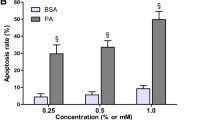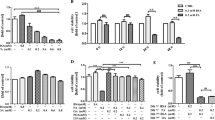Abstract
Artemisinin (ART) and dihydroartemisinin (DHA) are first-line antimalarial drugs and have been reported to have anti-obesity effects. Hyperlipidemia is associated with β-cell damage in obese subjects, which could contribute to the pathogenesis of type 2 diabetes. In addition to their anti-obesity effects, ART and DHA also have protective roles in some diseases. Thus, we investigated the effects of ART and DHA in palmitate-induced β-cell apoptosis and the underlying mechanism. In this study, the rat pancreatic β-cell line INS-1 and mouse pancreatic β-cell line MIN6 were cultured with palmitate (PA) (0.1 mM) to induce cell apoptosis in the presence or absence of ART or DHA. Cell apoptosis was investigated by using flow cytometry, and the expression of ER stress markers, including CHOP, GRP78 and PDI, was detected by Western blotting and/or qRT-PCR. The results showed that ART and DHA significantly increased the apoptosis of β-cells induced by PA and exacerbated the ER stress caused by PA. An inhibitor of ER stress, 4-phenylbutyric acid (4-PBA), significantly ameliorated cell apoptosis caused by ART and DHA in PA-treated β-cells, consistent with the inhibition of ER stress. Together, the findings from the current study suggested that ART and DHA may promote lipid disorder-associated β-cell injury via enhancing ER stress when they were used to treat obesity.














Similar content being viewed by others
References
Giannangelo C, Fowkes FJI, Simpson JA, Charman SA, Creek DJ (2019) Ozonide antimalarial activity in the context of artemisinin-resistant malaria. Trends Parasitol. https://doi.org/10.1016/j.pt.2019.05.002
Vydyam P, Dutta D, Sutram N, Bhattacharyya S, Bhattacharyya MK (2019) A small-molecule inhibitor of the DNA recombinase Rad51 from Plasmodium falciparum synergizes with the antimalarial drugs artemisinin and chloroquine. J Biol Chem 294(20):8171–8183. https://doi.org/10.1074/jbc.RA118.005009
Esu EB, Effa EE, Opie ON, Meremikwu MM (2019) Artemether for severe malaria. Cochrane Database Syst Rev. https://doi.org/10.1002/14651858.CD010678.pub3
Qu C, Ma J, Liu X, Xue Y, Zheng J, Liu L, Liu J, Li Z, Zhang L, Liu Y (2017) Dihydroartemisinin exerts anti-tumor activity by inducing mitochondrion and endoplasmic reticulum apoptosis and autophagic cell death in human glioblastoma cells. Front Cell Neurosci 11:310. https://doi.org/10.3389/fncel.2017.00310
Liu X, Lu J, Liao Y, Liu S, Chen Y, He R, Men L, Lu C, Chen Z, Li S, Xiong G, Yang S (2019) Dihydroartemisinin attenuates lipopolysaccharide-induced acute kidney injury by inhibiting inflammation and oxidative stress. Biomed Pharmacother 117:109070. https://doi.org/10.1016/j.biopha.2019.109070
Guo Y, Fu W, Xin Y, Bai J, Peng H, Fu L, Liu J, Li L, Ma Y, Jiang H (2018) Antidiabetic and antiobesity effects of artemether in db/db mice. Biomed Res Int 2018:8639523. https://doi.org/10.1155/2018/8639523
Williams EP, Mesidor M, Winters K, Dubbert PM, Wyatt SB (2015) Overweight and obesity: prevalence, consequences, and causes of a growing public health problem. Curr Obes Rep 4(3):363–370. https://doi.org/10.1007/s13679-015-0169-4
Lin Y, Ren N, Li S, Chen M, Pu P (2019) Novel anti-obesity effect of scutellarein and potential underlying mechanism of actions. Biomed Pharmacother 117:109042. https://doi.org/10.1016/j.biopha.2019.109042
Sargsyan E, Artemenko K, Manukyan L, Bergquist J (1861) Bergsten P (2016) Oleate protects beta-cells from the toxic effect of palmitate by activating pro-survival pathways of the ER stress response. Biochim Biophys Acta 9:1151–1160. https://doi.org/10.1016/j.bbalip.2016.06.012
Karaskov E, Scott C, Zhang L, Teodoro T, Ravazzola M, Volchuk A (2006) Chronic palmitate but not oleate exposure induces endoplasmic reticulum stress, which may contribute to INS-1 pancreatic beta-cell apoptosis. Endocrinology 147(7):3398–3407. https://doi.org/10.1210/en.2005-1494
Spiller S, Bluher M, Hoffmann R (2018) Plasma levels of free fatty acids correlate with type 2 diabetes mellitus. Diabetes Obes Metab 20(11):2661–2669. https://doi.org/10.1111/dom.13449
Bae GD, Park EY, Baek DJ, Jun HS, Oh YS (2018) Liquiritigenin prevents palmitate-induced beta-cell apoptosis via estrogen receptor-mediated AKT activation. Biomed Pharmacother 101:348–354. https://doi.org/10.1016/j.biopha.2018.02.097
Lu P, Zhang FC, Qian SW, Li X, Cui ZM, Dang YJ, Tang QQ (2016) Artemisinin derivatives prevent obesity by inducing browning of WAT and enhancing BAT function. Cell Res 26(10):1169–1172. https://doi.org/10.1038/cr.2016.108
Hanboonkunupakarn B, Ashley EA, Jittamala P, Tarning J, Pukrittayakamee S, Hanpithakpong W, Chotsiri P, Wattanakul T, Panapipat S, Lee SJ, Day NP, White NJ (2014) Open-label crossover study of primaquine and dihydroartemisinin-piperaquine pharmacokinetics in healthy adult thai subjects. Antimicrob Agents Chemother 58(12):7340–7346. https://doi.org/10.1128/AAC.03704-14
Eizirik DL, Cardozo AK, Cnop M (2008) The role for endoplasmic reticulum stress in diabetes mellitus. Endocr Rev 29(1):42–61. https://doi.org/10.1210/er.2007-0015
Elkhidir AE, Eltaher HB, Mohamed AO (2017) Association of lipocalin-2 level, glycemic status and obesity in type 2 diabetes mellitus. BMC Res Notes 10(1):285. https://doi.org/10.1186/s13104-017-2604-y
Sargsyan E, Cen J, Roomp K, Schneider R, Bergsten P (2018) Identification of early biological changes in palmitate-treated isolated human islets. BMC Genomics 19(1):629. https://doi.org/10.1186/s12864-018-5008-z
Guo T, Liu T, Sun Y, Liu X, Xiong R, Li H, Li Z, Zhang Z, Tian Z, Tian Y (2019) Sonodynamic therapy inhibits palmitate-induced beta cell dysfunction via PINK1/Parkin-dependent mitophagy. Cell Death Dis 10(6):457. https://doi.org/10.1038/s41419-019-1695-x
Li J, Du H, Zhang M, Zhang Z, Teng F, Zhao Y, Zhang W, Yu Y, Feng L, Cui X, Zhang M, Lu T, Guan F, Chen L (2019) Amorphous solid dispersion of Berberine mitigates apoptosis via iPLA2beta/Cardiolipin/Opa1 pathway in db/db mice and in Palmitate-treated MIN6 beta-cells. Int J Biol Sci 15(7):1533–1545. https://doi.org/10.7150/ijbs.32020
Kim JY, Bacha F, Tfayli H, Michaliszyn SF, Yousuf S, Arslanian S (2019) Adipose tissue insulin resistance in youth on the spectrum from normal weight to obese and from normal glucose tolerance to impaired glucose tolerance to type 2 diabetes. Diabetes Care 42(2):265–272. https://doi.org/10.2337/dc18-1178
Oikonomou EK, Antoniades C (2019) The role of adipose tissue in cardiovascular health and disease. Nat Rev Cardiol 16(2):83–99. https://doi.org/10.1038/s41569-018-0097-6
Muppala S, Konduru SKP, Merchant N, Ramsoondar J, Rampersad CK, Rajitha B, Mukund V, Kancherla J, Hammond A, Barik TK, Mannarapu M, Alam A, Basha R, Bramhachari PV, Verma D, Sushma PS, Pattnaik S, Nagaraju GP (2017) Adiponectin: its role in obesity-associated colon and prostate cancers. Crit Rev Oncol Hematol 116:125–133. https://doi.org/10.1016/j.critrevonc.2017.06.003
Kim KE, Ko KH, Heo RW, Yi CO, Shin HJ, Kim JY, Park JH, Nam S, Kim H, Roh GS (2016) Artemisia annua leaf extract attenuates hepatic steatosis and inflammation in high-fat diet-fed mice. J Med Food 19(3):290–299. https://doi.org/10.1089/jmf.2015.3527
Zeng W, Tang J, Li H, Xu H, Lu H, Peng H, Lin C, Gao R, Lin S, Lin K, Liu K, Jiang Y, Weng J, Zeng L (2018) Caveolin-1 deficiency protects pancreatic beta cells against palmitate-induced dysfunction and apoptosis. Cell Signal 47:65–78. https://doi.org/10.1016/j.cellsig.2018.03.013
Hong SW, Lee J, Cho JH, Kwon H, Park SE, Rhee EJ, Park CY, Oh KW, Park SW, Lee WY (2018) Pioglitazone attenuates palmitate-induced inflammation and endoplasmic reticulum stress in pancreatic beta-cells. Endocrinol Metab 33(1):105–113. https://doi.org/10.3803/EnM.2018.33.1.105
Lu M, Sun L, Zhou J, Zhao Y, Deng X (2015) Dihydroartemisinin-induced apoptosis is associated with inhibition of sarco/endoplasmic reticulum calcium ATPase activity in colorectal cancer. Cell Biochem Biophys 73(1):137–145. https://doi.org/10.1007/s12013-015-0643-3
Bridgford JL, Xie SC, Cobbold SA, Pasaje CFA, Herrmann S, Yang T, Gillett DL, Dick LR, Ralph SA, Dogovski C, Spillman NJ, Tilley L (2018) Artemisinin kills malaria parasites by damaging proteins and inhibiting the proteasome. Nat Commun 9(1):3801. https://doi.org/10.1038/s41467-018-06221-1
Zhu M, Guo M, Fei L, Pan XQ, Liu QQ (2014) 4-phenylbutyric acid attenuates endoplasmic reticulum stress-mediated pancreatic beta-cell apoptosis in rats with streptozotocin-induced diabetes. Endocrine 47(1):129–137. https://doi.org/10.1007/s12020-013-0132-7
Chen X, Bian M, Zhang C, Kai J, Yao Z, Jin H, Lu C, Shao J, Chen A, Zhang F, Zheng S (2018) Dihydroartemisinin inhibits ER stress-mediated mitochondrial pathway to attenuate hepatocyte lipoapoptosis via blocking the activation of the PI3K/Akt pathway. Biomed Pharmacother 97:975–984. https://doi.org/10.1016/j.biopha.2017.11.010
Funding
This work was supported by Grants from the Nanjing Science and Technology Commission (ZKX15041) and Nanjing National Commission on Health and Family Planning (ZKX16057).
Author information
Authors and Affiliations
Corresponding authors
Ethics declarations
Conflict of interest
The authors declare that there are no conflicts of interest.
Additional information
Publisher's Note
Springer Nature remains neutral with regard to jurisdictional claims in published maps and institutional affiliations.
Rights and permissions
About this article
Cite this article
Chen, K., Hua, H., Zhu, Z. et al. Artemisinin and dihydroartemisinin promote β-cell apoptosis induced by palmitate via enhancing ER stress. Apoptosis 25, 192–204 (2020). https://doi.org/10.1007/s10495-019-01587-z
Published:
Issue Date:
DOI: https://doi.org/10.1007/s10495-019-01587-z




